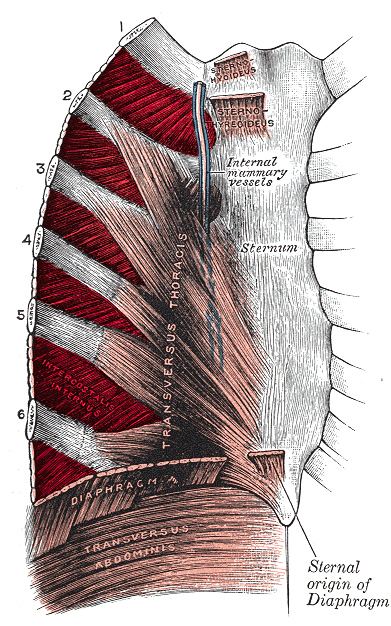Origin ribs 1-11 Artery intercostal arteries Latin Musculi intercostales | Insertion ribs 2-12 Nerve intercostal nerves | |
 | ||
Actions Elevation or Depression of the Ribs | ||
Intercostal muscles are several groups of muscles that run between the ribs, and help form and move the chest wall. The intercostal muscles are mainly involved in the mechanical aspect of breathing. These muscles help expand and shrink the size of the chest cavity to facilitate breathing.
Contents
Structure
There are three principal layers;
- External intercostal muscles aid in quiet and forced inhalation. They originate on ribs 1-11 and have their insertion on ribs 2-12. The external intercostals are responsible for the elevation of the ribs and bending them more open, thus expanding the transverse dimensions of the thoracic cavity.
- Internal intercostal muscles aid in forced expiration (quiet expiration is a passive process). They originate on ribs 1-11 and have their insertions on ribs 2-12.Their fibers pass inferior and posterior to insert on the upper margin of the rib and costal cartilage below.(source) The internal intercostals are responsible for the depression of the ribs and bending them inward, thus decreasing the transverse dimensions of the thoracic cavity.
- Innermost intercostal muscle, the deep layers of the internal intercostal muscles which are separated from them by a neurovascular bundle. This in turn is composed of:
- Transversus thoracis muscle
- Sternocostal muscle
- Subcostalis muscle
Innervation
Both the external and internal muscles are innervated by the intercostal nerves (the ventral rami of thoracic spinal nerves), are supplied by the intercostal arteries, and are drained by the intercostal veins. Their fibers run in opposite directions.
Function
The scalene muscles, which also move the chest wall and have a function in inhalation, are also intercostal muscles, just not one of the three principal layers.
References
Intercostal muscle Wikipedia(Text) CC BY-SA
